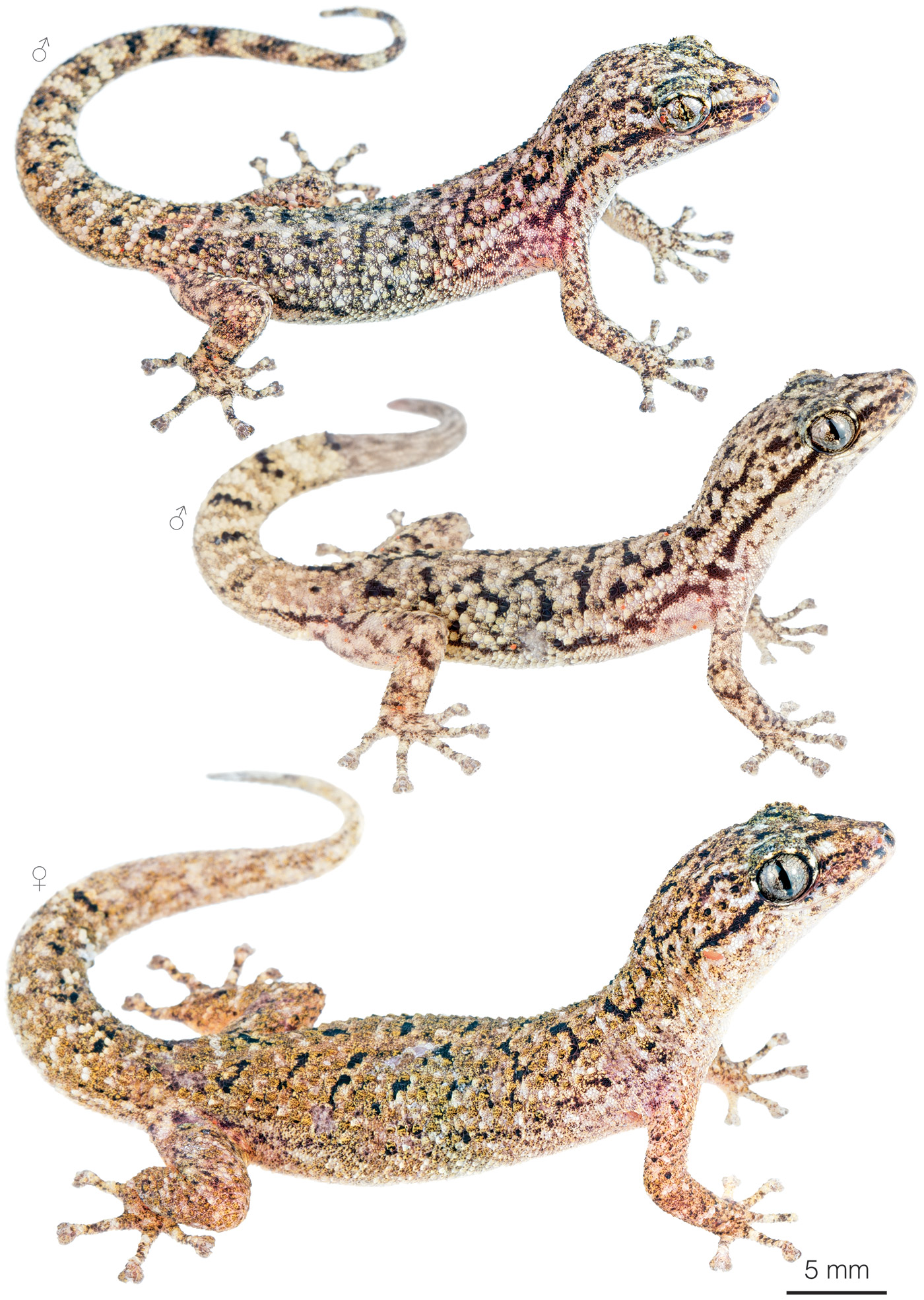Published May 30, 2019. Updated December 31, 2023. Open access. | Purchase book ❯ |
Dwarf Leaf-toed Gecko (Phyllodactylus pumilus)
Reptiles of Ecuador | Sauria | Phyllodactylidae | Phyllodactylus pumilus
English common name: Dwarf Leaf-toed Gecko.
Spanish common names: Geco enano de Manabí, salamanquesa enana de Manabí.
Recognition: ♂♂ 12.8 cmMaximum distance from the snout to the tip of the tail. Snout–vent length=5.1 cm. ♀♀ 10.7 cmMaximum distance from the snout to the tip of the tail. Snout–vent length=4.4 cm..1 Phyllodactylus pumilus is easily distinguishable from other geckos occurring in the dry forests of west-central Ecuador by having narrow and rounded digital disks and dorsal surfaces covered by rows of densely packed tubercles that are strongly keeled, large, and trihedral (Fig. 1).1 The dorsal coloration is usually pale sandy brown with black sinuous markings and a thin black postocular stripe (Fig. 1).1 Phyllodactylus pumilus differs from P. reissii by being smaller, having tubercles on the tail, and boasting more densely packed dorsal tubercles.1,2

Figure 1: Individuals of Phyllodactylus pumilus from Punta Prieta, Manabí province, Ecuador.
Natural history: Phyllodactylus pumilus is a terrestrial gecko that inhabits dry shrublands and seasonally dry forests within 20 km from the coastline. A crepuscular and nocturnal species, this gecko forages at ground level or on trees and cliffs.1,2 Dwarf Leaf-toed Geckos also colonize walls in human settlements and boats stranded on the beach.2 During the day, they remain hidden in crevices or under rocks, logs, and loose bark of trees and stumps.1,2 Individuals having regenerated tail portions and scars in the body are common in some coastal cliffs, suggesting intense predation attempts by native and exotic predators.2
Conservation: Near Threatened Not currently at risk of extinction, but requires some level of management to maintain healthy populations.. Phyllodactylus pumilus is proposed to be included in this category because it occurs in protected areas and persists and even thrives in human-modified habitats. However, the species is restricted to an extremely small (under 5,000 km2) area that is becoming increasingly urbanized and where feral cats and competitive introduced geckos are extremely abundant. Phyllodactylus pumilus has been found living alongside the larger native gecko P. reissii and the introduced gecko Hemidactylus frenatus, two species that could competitively displace the smaller resident populations of P. pumilus.2
Distribution: Phyllodactylus pumilus is endemic to an area of approximately 3,688 km2 along the coast of Manabí province, west-central Ecuador (Fig. 2).

Figure 2: Distribution of Phyllodactylus pumilus in Ecuador. The star corresponds to the type locality: Manta, 1 km S of. See Appendix 1 for a complete list of the presence localities included in the map.
Etymology: The generic name Phyllodactylus comes from the Greek words phyllon (=leaf) and daktylos (=finger),4 and refers to the leaf-shaped fingers characteristic of this group of geckos. The specific epithet pumilus is a Latin word meaning “dwarfish.”4 It probably refers to the fact that this gecko is smaller than the co-occurring P. reissii.
See it in the wild: Phyllodacytlus pumilus can be seen almost every night in coastal cliffs throughout its area of distribution. A prime location for this species is Punta Prieta, where the geckos are present in both natural substrates and man-made structures.
Author and photographer: Alejandro ArteagaaAffiliation: Fundación Khamai, Reserva Arlequín, Ecoruta Paseo del Quinde km 56, Santa Rosa de Mindo, Pichincha 171202, Ecuador.
How to cite? Arteaga A (2023) Dwarf Leaf-toed Gecko (Phyllodactylus pumilus). In: Arteaga A, Bustamante L, Vieira J (Eds) Reptiles of Ecuador: Life in the middle of the world. Available from: www.reptilesofecuador.com. DOI: 10.47051/ZUSF7638
Literature cited:
- Dixon JR, Huey RB (1970) Systematics of the lizards of the gekkonid genus Phyllodactylus of mainland South America. Los Angeles County Museum Contributions in Science 192: 1–78. DOI: 10.5962/p.241179
- Torres-Carvajal O, Carvajal-Campos A, Barnes CW, Nicholls G, Pozo-Andrade MJ (2013) A new Andean species of Leaf-toed Gecko (Phyllodactylidae: Phyllodactylus) from Ecuador. Journal of Herpetology 47: 384–390. DOI: 10.1670/12-017
- Field notes, Reptiles of Ecuador book project.
- Brown RW (1956) Composition of scientific words. Smithsonian Books, Washington, 882 pp.
Appendix 1: Locality data used to create the distribution map of Phyllodactylus pumilus in Ecuador (Fig. 2). Go to the section on symbols and abbreviations for a list of acronyms used. Asterisk (*) indicates type locality.
| Country | Province | Locality | Source |
| Ecuador | Manabí | Bosque Protector Cerro Seco | Reptiles of Ecuador book database |
| Ecuador | Manabí | Cabo San Mateo | Reptiles of Ecuador book database |
| Ecuador | Manabí | Cabuyal | iNaturalist; photo examined |
| Ecuador | Manabí | Jipijapa | USNM 167184; VertNet |
| Ecuador | Manabí | Jipijapa, 8 km W of | Carvajal-Campos & Guerra-Correa 2020 |
| Ecuador | Manabí | Manta | Dixon & Huey 1970 |
| Ecuador | Manabí | Manta, 1 km S of* | Dixon & Huey 1970 |
| Ecuador | Manabí | Manta, 6 km E of | Dixon & Huey 1970 |
| Ecuador | Manabí | Montecristi, 5 km W of | Dixon & Huey 1970 |
| Ecuador | Manabí | Portoviejo, 11 Km W of | Dixon & Huey 1970 |
| Ecuador | Manabí | Punta Prieta | This work; Fig. 1 |
| Ecuador | Manabí | Reserva Natural Punta Gorda | iNaturalist; photo examined |
| Ecuador | Manabí | San Lorenzo | Reptiles of Ecuador book database |
| Ecuador | Manabí | San Vicente, 9 km N of | Dixon & Huey 1970 |